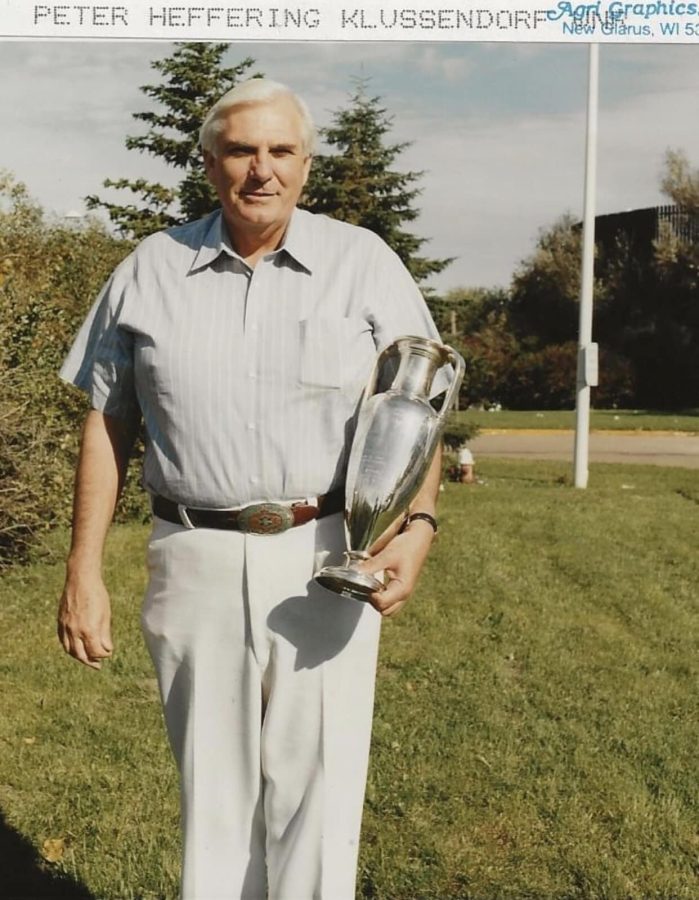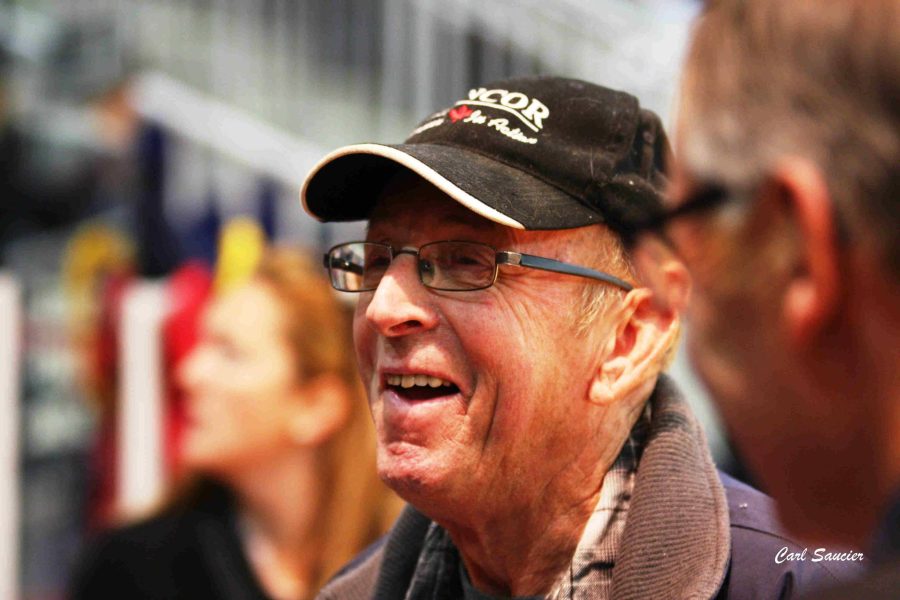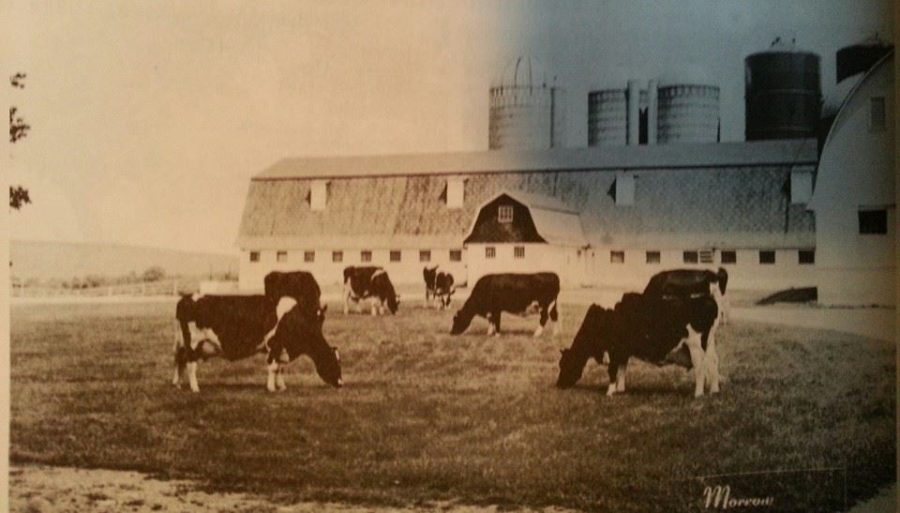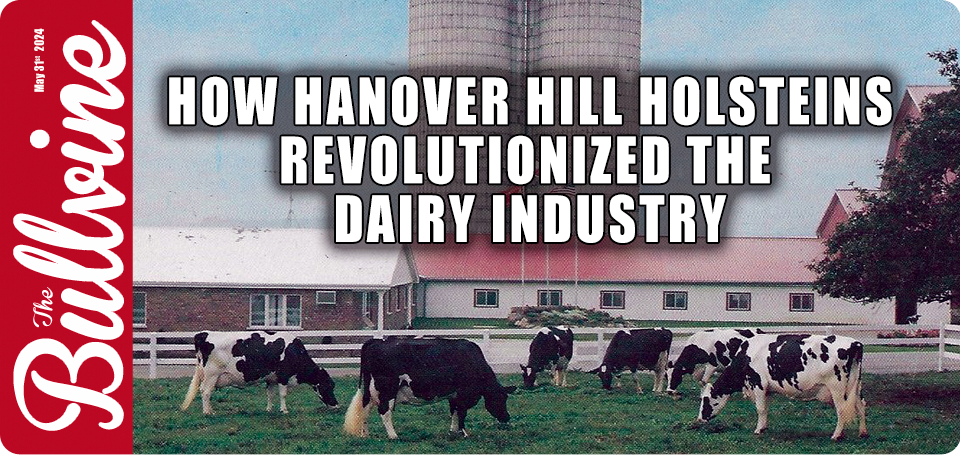Uncover the story of how Hanover Hill Holsteins revolutionized the dairy industry. Which groundbreaking practices distinguished them and fueled their extraordinary success? Continue reading to learn more.
From Ontario’s sweeping, pastoral landscapes to the high-stakes arenas of international dairy competitions, one name has risen above the rest in the annals of Holstein excellence—Hanover Hill Holsteins. This astounding legacy of Heffering and Trevena weaves a compelling narrative of visionary ambition, unparalleled dedication, and a relentless pursuit of genetic superiority that has revolutionized not only the Canadian Holstein lineage but the global dairy breeding industry. At Hanover Hill, the symbiotic partnership of Peter Heffering and Ken Trevena set in motion a series of transformative events that would echo through the entire dairy industry.
“We didn’t set out to create a dynasty; our aim was simple: breed the best Holsteins in the world,” confided Peter Heffering in a rare interview, encapsulating the humble yet grand aspirations that have driven their unprecedented achievements.
Their journey is a masterclass in breeding brilliance and innovative farm management. Hanover Hill Holsteins became an epitome of quality and consistency, producing record-breaking cattle that met and exceeded the highest industry standards. The meticulous curation of bloodlines and the strategic incorporation of cutting-edge reproductive technologies were merely the beginning. Among their myriad accomplishments, one can find cows and bulls whose contributions to milk production and genetic improvement are almost legendary, leaving an indelible mark on the breed.
In the ensuing sections, we will delve deeper into the intricate tapestry of Hanover Hill’s remarkable history, examining the methods, milestones, and influential figures that cemented its place at the pinnacle of Holstein breeding. Join us as we uncover the secrets behind Hanover Hill’s success and explore how this dynamic duo changed the course of Canadian dairy farming and set new global benchmarks for excellence.
Click here to learn more about Hanover Hill and the many great breeders in Holstein’s History.

The Arrival of Hanover Hill
In the spring of 1973, two ambitious cattlemen from New York erupted onto the Canadian Holstein scene, transforming the industry with their vision. Peter Heffering and Ken Trevena, already recognized for their successful herds, moved to a 300-acre farm in Port Perry, Ontario, and named it Hanover Hill. Their arrival heralded a new chapter in Canadian Holstein breeding, with their cattle quickly racking up prestigious awards.
Their approach was clear yet transformative:
- Breeding deep cow families with top sires
- Promoting high production
- Dominating North American show arenas
With innovative marketing and extensive advertising, Hanover Hill’s bloodline gained a global reputation for excellence. This transition aligned with Canada’s shift towards new US genetics, which Heffering and Trevena expertly harnessed.
A shining example of their triumph is the Hanover Hill-bred bull Starbuck, one of the most influential sires in Holstein history. Starbuck’s ability to sire high-quality cattle with elevated protein levels made him a favorite among North American breeders, blending Canadian and American Holstein genetics. Hanover Hill’s legacy of innovative breeding and superior cattle continues to profoundly shape the global Holstein population.

Peter Heffering: An Unlikely Path to Farming
In the late 1940s, a white-haired gentleman asked Dr. Russell Heffering in White Plains, New York, about his son’s career plans. Dr. Heffering replied, “He wants to be a farmer,” supporting Peter’s passion for agriculture.
The Heffering family’s farming roots extended to Peter’s uncles, James and Harold. James owned Railroad Stables in Whitby, Ontario, and bred Speedy Irish, a racehorse who earned significant accolades before tragically passing away. And Harold, a Toronto-based doctor, moved his farm northward as Toronto expanded, eventually donating land for a seminary in Keswick.
Peter’s love for farming ignited during a 1945 summer on Chuck Waustlich’s farm in Woodstock, Vermont. His dedication led to participation in local 4-H programs, where he impressed farmers like Warner Townsend and Russell Crane. Peter’s dream of dairy farming grew stronger by high school, often sketching barn layouts.
Peter pursued animal husbandry at New York State University, graduating in 1951. He then joined Beacon Milling Company, a Holstein farm, where he engaged in both farm duties and advanced dairy research. He contributed to the breeding program with strategic cattle acquisitions, enhancing Beacon’s genetics.
In 1952, Peter married, balancing a modest income with his wife’s earnings as a nurse. Their combined commitment underscored their determination to own a dairy farm eventually.

The Catalyst to a Formidable Partnership
Among the influential figures at Hanover Hill, Marvin Colburn’s impact stands out, albeit more for his recommendation than his time there. A New Hampshire native, Colburn lost his Guernsey herd to Bang’s disease, leading him to seek work at Beacon Farm. His physical challenge—a shorter left leg—made the job unsustainable. After just two weeks, he informed Peter Heffering that he needed to leave, planning to return to university for a doctorate. However, his brief tenure led to a crucial connection. He recommended Kenneth Wesley Trevena, who was managing a dairy farm in Concord, New Hampshire, for Dr. Robert O. Blood.
From Lisbon, New Hampshire, Kenneth Wesley Trevena pursued agriculture at the University of New Hampshire, which is known for its agricultural solid program. Trevena’s education, supervised by Ken Fowler, included hands-on experience in animal husbandry, providing him with essential skills.
After graduation, Trevena worked for Dr. Robert O. Blood, a demanding employer who would later become governor. Blood’s strict management style taught Trevena valuable lessons, such as managing veterinary care efficiently.
By 1958, after five years with Dr. Blood, Trevena was ready for a change. Now back in New Hampshire, Colburn informed him about an opportunity at Beacon Farm. Trevena’s interview with Peter Heffering sealed his decision, and that summer, he joined Beacon Farm. This marked the start of a pivotal partnership with Heffering, which would become the foundation of Hanover Hill’s legacy.
A Transformative Year: The Turning Point of 1961
In 1961, after a decade at Beacon, Peter Heffering sought new opportunities. Heffering found a promising venture with Frank Goodyear, a key owner of Amcana Dictator Model. Weary from managing his Danboro, Pennsylvania, farm, Goodyear leased it to Heffering in return for overseeing some of his animals.
At Beacon, Heffering had built a notable herd featuring exemplary cows like Maroy Model Abbekerik (EX), Mearscrest Ormsby Trixie (EX), and Crestlane Faforit Posch (VG). As Heffering prepared to relocate, his colleague Ken Trevena was drafted into the US Army. Heffering, showing dedication, transported Trevena’s belongings alongside his prized herd.
Heffering scouted eastern Ontario with Cliff Cook during this period, acquiring valuable cattle such as Stella Orchard Grove Tensen and Stella Orchard Grove Ormsby. Tensen, purchased for $500, soon won accolades and a nomination for All-American status. Ormsby, scoring an impressive 94, produced high-quality offspring and yields.
Despite efficient management, Goodyear sold the Danboro farm within a year. Heffering, anticipating change, placed a full-page ad in Holstein World’s December 26, 1961 issue, seeking a new farm in the northeastern United States. Finally, Heffering’s journey advanced thanks to James Houlahan, inspired by a Farm Journal Magazine writer’s recommendation.
A Whisper, A Split, and a New Beginning
By 1967, Houlahan reconsidered his involvement in the cattle business, influenced by actor James Cagney. This led to the end of his partnership with Heffering despite their rise to prominence in the Holstein world.
During this period, Dave Younger, farm manager for Henry Christal’s Hanover Hill Guernseys, informed Heffering of an available farm in Amenia, New York, that Christal would rent to them, contingent upon their success at the upcoming Tara Hills dispersal.
On March 25, 1968, the Tara Hills dispersal saw 205 head averaging $1,900 each. Heffering and Trevena set a world record with the sale of Future Hope Reflector Blacky for $44,000. They purchased 41 heads for $127,250, including Heffering Stella Ormsby and Thornlea Tara Hills Flossie, pivotal to their new herd.
Their merchandising skills drew praise with the May 10, 1968 issue of Holstein World noting: “The sheer size of the crowd … states and countries represented … So many Canadian visitors ever attended no sale in the States… The Tara Hills dispersal joins the growing list of great breed sales.”
Later, in 1968, Heffering and Trevena took over Christal’s No. 2 farm, four miles north of Amenia, solidifying the foundation of their new herd based on the exceptional cattle from the Tara Hills dispersal.

The Proven Formula: From Amenia Farm to National Acclaim
At Amenia Farm, Heffering and Trevena adhered to a proven methodology:
- Meticulous management
- A well-traveled show herd
- A strategic breeding program
- Prominent ads in Holstein World
By July 1968, they proudly declared, “We think we have one of the finest groups of foundation Holsteins ever assembled.” Their milking herd averaged just under 90 points. During their first year, Thornlea Tara Hills Flossie was named All-American four-year-old, and Heffering Tempest I, Stella earned Reserve two-year-old honors. “Hanover Hill” debuted in a Holstein World ad on January 10, 1969.
The Amenia farm housed 100 head in two rows of 50 cows. Each day at 1:00 AM and PM, Heffering and Trevena, with minimal staff, managed the herd using two milking machines each. Despite their tireless efforts, they needed more time. In 1969, Heffering collaborated with industry experts to create Hanover Hill Sales and Service, featuring an iconic ladder logo symbolizing “your ladder to success.”
Their partnership often made headlines. Alongside Brigeen Farms, they bought Gray View Coral Shamrock (VG 89) for a record $40,000.00 at the 1970 World Premiere. At the 1971 Royal Winter Fair, they showcased the Junior Champion Heifer, Hanover Hill Ruben R. Ruby, and won the Premier Breeder banner. With the lease on the Amenia farm expiring on January 1, 1973, a strategic move and sale were inevitable.
The Unprecedented Success of the 1972 Hanover Hill Dispersal
The Hanover Hill dispersal on November 10 and 11, 1972, marked an extraordinary milestone in dairy cattle history, setting six world records and surpassing one million dollars in sales. With 286 head selling for $1,143,675, it garnered unprecedented attention. A standout was Johns Lucky Barb (EX) and her progeny, which cumulatively sold for $350,500, averaging $43,812.50 each. Johns Lucky Barb, close to calving, fetched a remarkable $55,000 from R.R. Dennis, Oak Ridges, Ontario.
Another notable sale was Hanover Hill Triple Threat, a red and white Holstein bull, which American Breeders Service from DeForest, Wisconsin, purchased for $60,000. Hanover Hill Astro Lucky Barb, a daughter of Paclamar Astronaut (EX-GM), was sold for $51,000 to Madeira Enterprises, showcasing the exceptional quality of the herd. Glenafton Citation Gay was sold to Ceylon R. Snider for $30,000, setting a record for a heifer calf.
Managed by Hanover Hill Sales and Service alongside Shore Holsteins Ltd. and Brubacher Bros. Limited, this event saw 150 heads sold to international buyers. The Holstein World aptly named it “the record-shattering Hanover Hill Sale.”
Crossing Borders: Hanover Hill’s Canadian Strategic Shift
The move to Canada was strategic, hinging on a well-established cross-border relationship. During the late 1950s and 1960s, Heffering and Trevena had sourced animals from Canada and sold cattle to Canadian breeders, often showcasing their stock at the Royal Winter Fair. This enduring connection paved the way for their 1973 migration, driven by disagreements with the US artificial insemination industry.
In the US, geneticists favored an index-based system to measure a bull’s production, neglecting crucial traits like cow families, type, and longevity. Heffering criticized this “numbers game,” advocating for a holistic approach. Hanover Hill’s philosophy of robust cow families and longevity aligned better with Canadian AI practices.
Relocating to a 150-acre farm near Port Perry, Ontario, in 1973 marked a pivotal shift for Hanover Hill. An event in August inaugurated their new dairy barn, heralding a promising era. Over the next twenty-five years, they solidified their legacy, with over one hundred Hanover Hill bulls proven in Canada, gaining recognition that eluded them in the US.
Orchestrating Excellence: The Strategic Operations of Hanover Hill
Hanover Hill’s operations were meticulously orchestrated. Ken Trevena oversaw daily herd activities, while Pete Heffering managed shows, merchandising, and business strategies. Both drove the innovative breeding program toward excellence.
The herd typically numbered around 375 cattle, including 100 milking cows. Embryo transfer was commonplace, necessitating numerous recipient heifers. Heffering and Trevena recognized the need for Canada to enhance its grain feeding practices to remain globally competitive. While Hanover Hill produced its roughage, most other feed types were purchased. With limited pasture access, milk cows were fed haylage, hay, and corn silage, with high producers receiving up to 24 pounds of a 20% protein grain supplement. Essential oat rollers were common in barns, and rations lacked complexity. Forage harvesting methods were just beginning to gain sophistication. Heffering anticipated that innovations adopted in the US would soon influence Canada, foreseeing significant changes.
Their ambition was a pedigreed herd, with each member boasting three generations of ‘Very Good’ or ‘Excellent’ ratings, producing 20,000 pounds of milk with a 3.7% test. Notable cows in Hanover Hill’s early years included Hanover Hill Telstar Barb (EX), Cathland Countess (EX), and Mil-R-Mor Roxette (EX). Their herd featured daughters of Elevation and Fond Matt, with semen from S-W-D Valiant, Hanover Hill Triple Threat, among others.

The Hanover Hill Cow Families
- Johns Lucky Barb (EX-97-4E-GMD-5*): played a pivotal role in Hanover Hill’s ascent, with accolades from the Ontario County Black & White Show and the New York State Exposition, All-American nominations, a production peak of 29,052 pounds of 4.7% milk, and a legacy cemented by her progeny setting eight world price records at the 1972 Hanover Hill Dispersal.
- Mil-R-Mor Roxette (EX-GMD-30*): was a cornerstone in Hanover Hill’s success, acquiring national and international acclaim through her remarkable genetic legacy and high-yield daughters, fetching premium prices globally.
- Sleepy-Hollow Marq I Papoose (EX-6*): bred by Sleepy Hollow Certified Milk Farms, epitomizes Heffering and Trevena’s commitment to strong maternal lines with notable descendants and exceptional production records.
- Tora Triple Threat Lulu (EX-GMD-11*): emerged as a cornerstone of Hanover Hill’s legacy, her genetic impact profoundly seen through her exceptional progeny, including Hanover Hill’s influential bulls and award-winning daughters, solidifying her place in dairy history.
- Overlook Farm Anna Marquis (EX): Romandale Reflection Marquis (EX ST) daughter, OverlookFarm Anna Marquis, imported by Peter Heffering in 1965, produced notable progeny, including Hanover Hill Astro Anna, who secured multiple accolades and became an influential figure in dairy genetics.
- Gor Wood-D Bootmaker Jennifer (EX-GMD-13°) and Gor Wood-D Elevation Valentine (RX-GMD-5*): These Holsteins, sired by renowned bulls, vastly contributed to Hanover Hill’s legacy through their exemplary milk production and high classifications.
- Cathland Countess (EX-7*): From the Neil Gatheart herd in Cavan, Ontario, Cathland Countess emerged as a cow of exceptional type and reproductive efficiency, known for her impressive lineage and remarkable progeny that exemplified Hanover Hill’s genetic vision on the dairy industry.
- Brookview Tony Charity (EX-97-USA-11*) a legendary Holstein, set multiple records and became the first dairy animal to sell for over a million dollars in the 1985 sale.
- Woodmansees Sexation Megan Mae (EX-3*-GMD): an Ocean-View Sexation (VG) daughter, significantly contributed to Hanover Hill with her prodigious lineage and exceptional offspring performance in milk production and show accolades.
- Anacres Astronaut Ivanhoe (VG): Peter Heffering’s acquisition of Anacres Astronaut Ivanhoe, a record-setting cow with an illustrious lineage, and her subsequent progeny, including the transformative sire Hanoverhill Starbuck, epitomized Hanover Hill’s impact on Holstein breeding.
Nine Class Extra Sires
The genetics propagated by Hanover Hill have left an indelible mark on Holstein populations globally, primarily through their exemplary bulls in artificial insemination programs. Hanover Hill has disseminated superior genetics across North America and beyond, significantly enhancing the Holstein breed.
Hanover Hill bulls are favored across artificial insemination units worldwide. Notably, the farm produced nine Class Extra sires:
- Hanoverhill Starbuck (EX-Extra)
Starbuck, a progeny of Round Oak Rag Apple Elevation and Anacres Astronaut Ivanhoe, stands as a breed titan with global influence. - Hanover-Hill Inspiration (EX-Extra)
Inspiration, a son of S-W-D Valiant and Tora Triple Threat Lulu, left a remarkable legacy with high-production descendants like Wykholme Dewdrop Tacy. - Hanoverhill Raider (EX-Extra)
Raider, sired by Starbuck and out of Mil-R-Mor Roxette, quickly attained Class Extra status for producing Holsteins with superior feet, legs, and mammary systems. - Hanoverhill Lieutenant (EX-Extra)
Lieutenant, another Starbuck progeny, was proven in Ontario for his impressive production and type metrics, earning Extra status in 1994. - Hanover Hill Lincoln (EX-Extra)
Lincoln, also sired by Starbuck, was recognized for robust component yields and type transmission in Canada and Japan. - Hanover Hill-SS Clyde (EX-Extra)
Clyde, known for remarkable milk, fat, protein, and type ratings, was pivotal in showcasing Hanover Hill’s enduring legacy. - Hanoverhill Stardom (VG-Extra)
Stardom, with lineage tracing back to Hanoverhill Sheik Barb, excelled in producing Holsteins with admirable udder and leg traits. - Hanover-Hill Mirage (EX-Extra)
Mirage, earning Class Extra status in 1997, continued the illustrious lineage from Starbuck to Raider. - Hanoverhill Premier (EX-Extra)
Premier, the final addition to Hanover Hill’s distinguished sires, epitomizes the pinnacle of their breeding achievements.
Beyond these marquee sires, Hanover Hill’s legacy includes many impactful bulls. Twenty-one Hanover Hill bulls have earned Superior Type recognition, and seven have received Superior Production titles. As of January 1994, of sixty-four Hanover Hill bulls, thirty-five were proven superior in milk, fat, protein, and type metrics. Notably, Haverhill Bandit (EX-SP) was the breed’s top sire for milk.
A Trailblazing Journey Through the Show Ring: Legendary Accolades and Records
The ascent of Hanover Hill was marked by unprecedented success in the show ring. Amidst competitors’ struggles, Hanover Hill flourished, securing 140 All-American and 31 Reserve All-American nominations, along with 87 All-Canadian nominations, resulting in 23 All-Canadian and 21 reserves. They consistently were Premier Breeders at the Royal Winter Fair and the US Central National Show in Madison, Wisconsin, from 1983 to 1988. They also captured Premier Exhibitor banners six times at the Royal Winter Fair and thrice at Madison.
In 1981, their triumph at Madison was exceptional; they presented the Supreme Champion Female All Breeds, the Reserve Grand Female, and the top four aged cows in the mature milking class—an unprecedented achievement. Highlights included J-WS Monitor Racheal, JPG Standout Kandy, Tora Triple Threat Lulu, and Lawara Ormsby Prilly. Even their Gaydale Fury Sadie, Grand Champion at the London Championship Show, secured seventh place, affirming the herd’s elite status.
The following year, Heffering and Trevena’s show herd journeyed over 8,000 miles in 65 days to dominate three US National Shows and the Royal Winter Fair, winning Premier Exhibitor at all four. This year, Brookview Tony Charity emerged, destined to be a cornerstone of their success. She was the first cow to win Grand Champion at all three US Nationals in one year before triumphing at the Royal Winter Fair.
Heffering and Trevena uniquely exhibited six Supreme Champions at Madison, with standouts like Kandy, Racheal, and the four-time winner Charity. Their six-year Premier Breeder streak at the Royal Winter Fair was second only to Romandale Farms’ record from 1961 to 1967, eventually surpassed by Ferme Jacobs of QC.
Setting Records and Breaking Barriers: Hanover Hill’s Monumental Sales
In the mid-1980s, North America thrived under leaders Ronald Reagan and Brian Mulroney, with optimism buoyed by the US livestock tax credit system. Against this backdrop, Heffering and Trevena’s landmark sale on July 15-16, 1985, saw auctioneer Bob Shore preside over 2,500 attendees. A staggering 302 head sold for $7,039,200, averaging $23,308.61—shattering records. Highlighting the event, Brookview Tony Charity (EX) became the first dairy animal to sell for over a million dollars, fetching $1,450,000 from Steve Roman. Heffering and Trevena retained older cows to form a new herd nucleus.
Benefiting from their embryo transplant success, another sale on July 13-14, 1987, featured 201 head averaging $7,203.73. Notable sales included Hanover Hill Logic ET, a Starbucks son, for $204,000 and Bond Haven Star Roxy ET, a Starbucks daughter, for $32,000, with Hanover Hill retaining an interest.
By 1989, Hanover Hill’s story neared its end. On July 10-11, bidders from countries like Spain, Japan, and Brazil joined in, purchasing 341 lots averaging $14,711.73 and totaling $5,016,700—Canada’s third-highest dispersal average. Hanover Hill Star Lulu (VG) topped the sale at $635,000, making her the second highest-selling milking female in Canada. Her daughters, Hanoverhill Starmark Lulu and Hanoverhill Majesty Lulu fetched $95,000 and $32,000, respectively, enhancing Mountain View Holsteins’ thirty-two-head acquisition.
The complete dispersal on July 14-15, 1998, saw 289 heads sold for an average of $8,415.22, totaling $2,432,000. US buyers, leveraging a strong dollar, acquired 128 heads. Brazil led international purchases, followed by Germany. Horace Backus highlighted the significance of the Hanover Hill bloodline. Top sellers included Hanover-Hill Ches St. Lue ET at $126,000 and Bond Haven Aero Roxy (VG) at $115,000. The event coincided with victories by their Standardbred horses at nearby Tara Hills Stud Farm.
The Bottom Line
Hanover Hill Holsteins redefined the dairy industry through innovative breeding and strategic marketing. Under Peter Heffering and Ken Trevena, Hanover Hill set unmatched standards in Holstein cattle quality, achieving dominance both in sales and the show ring. Their strategic relocation to Canada and the landmark 1972 dispersal solidified their global influence.
Hanover Hill’s record-breaking achievements and influential breeding strategies continue to shape dairy operations worldwide. Their focus on genetic excellence, precise herd management, and strategic marketing remains vital, enhancing the dairy breeding sector’s strength and competitiveness.
Hanover Hill Holsteins’ pioneering spirit underscores that the quest for excellence is perpetual. Farmers and breeders must continue to embrace new technologies, sustainable practices, and cutting-edge genetic research to honor their legacy and advance the industry.
The Chosen Breed and The Holstein History by Edward Young Morwick
Anyone who appreciates history will enjoy either the US history (The Holstein History) or the Canadian History (The Chosen Breed) by Edward Morwick. Each of these books is so packed with information that they are each printed in two separate volumes. We had a chance to interview Edward – Edward Young Morwick – Country Roads to Law Office and got a real sense of his passion and quick wit which also come shining through in his books. Be sure to get your copies of this amazing compilation of Holstein history.
Key Takeaways:
- Innovative Breeding Programs: Hanover Hill’s focus on genetic superiority transformed the dairy industry’s standards.
- Strategic Partnerships: The alliance of Peter Heffering and Ken Trevena was instrumental in Hanover Hill’s success.
- Record-Breaking Achievements: Hanover Hill consistently set new benchmarks in cattle breeding, securing numerous accolades.
- Influence on the Global Stage: Their strategic operations and sales extended Hanover Hill’s reputation across borders, particularly with a significant impact in Canada.
- Enduring Legacy: The legacy of Hanover Hill is marked by its lasting influence on modern dairy farming practices and cattle genetics.

















